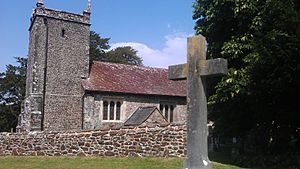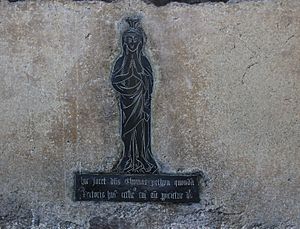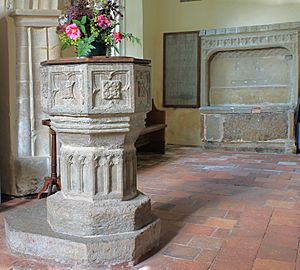St Mary the Virgin, Lytchett Matravers facts for kids
Quick facts for kids St Mary the Virgin, Lytchett Matravers |
|
|---|---|
 |
|
| 50°45′54″N 2°05′32″W / 50.76507°N 2.09224°W | |
| Location | Lytchett Matravers |
| Country | England |
| Denomination | Church of England |
| Previous denomination | Roman Catholic |
| History | |
| Founded | 12th century |
| Dedication | St Mary the Virgin |
| Architecture | |
| Heritage designation | Grade I listed |
| Designated | 20 November 1959 |
| Years built | 13th–15th centuries |
| Specifications | |
| Bells | 6 (Ring) |
| Tenor bell weight | 0 long tons 7 cwt (800 lb or 0.4 t) |
| Administration | |
| Parish | Lytchett Matravers |
| Deanery | Poole |
| Archdeaconry | Dorset |
| Episcopal area | Sherborne |
| Diocese | Salisbury |
| Province | Canterbury |
St Mary the Virgin is an old and important church in Lytchett Matravers, a village in Dorset, England. It belongs to the Church of England and is part of the Diocese of Salisbury. The church building is very special and is listed as a Grade I listed building. This means it's considered to be of exceptional historical and architectural interest.
Contents
History of St Mary's Church
How the Church Began
We don't know the exact date when St Mary's Church was first built. Records from the Domesday Book in 1086 show that Sir John Maltravers owned the land here. A later John Maltravers, who was buried in the church, was involved with King Edward II.
Right outside the church's north door, there's a very old yew tree. In the 1980s, experts estimated it was at least 1,700 years old! This suggests that this spot has been a holy place for a very long time, even before the current church was built.
Around the year 1200, a knight named Sir Walter Maltravers went on a Crusade to the Holy Land. It's thought that he might have ordered the church to be built next to his manor house while he was away. The oldest parts of the church, like the west tower, the nave (main part), and the chancel (area around the altar), were built around this time. The north aisle (a side section) was added later, in the 14th century.
The tower is the oldest part of the church building. Its main arch dates back to about 1200. The decorative tops of the tower, called pinnacles, were added around 1500. They have carvings of the Maltravers family symbol.
The row of arches on the north side of the nave was built around 1350 when the north aisle was added. There's also a special opening called a hagioscope or "squint." It's unusually large and allowed people in the north aisle to see the chancel and altar.
The Black Death and Church Life
Local stories say that the village of Lytchett Matravers moved away from the church during the terrible time of the Black Death. This was a deadly plague that spread across Europe. Because of this, the church slowly became less used for regular services. For a while, only the Rector (the priest) used it for daily prayers. Most people went to a smaller chapel in the village for worship.
Inside the church, there's a unique brass monument from the late 1400s. It remembers Thomas Pethyn, who was the rector from 1430 to 1470. The brass shows his body wrapped in a burial shroud, which was an unusual style for monuments in England at that time.
At the start of the 16th century, a lot of restoration work was done on the church, thanks to Dame Margarita Clements. Later, in the 17th century, the Arundel family, who had inherited the Maltravers estate, helped pay for more repairs to St Mary's. They also rebuilt the north aisle. After this, the chapel in the village closed, and everyone returned to St Mary's for worship.
English Civil War Impact
During the English Civil War, soldiers from the Parliamentarian army damaged a tomb in the north aisle. They removed and destroyed a special plaque that was on it. People believe this tomb belonged to a member of the Arundel or Maltravers family.
Changes in the 19th Century
In the 1800s, new wooden seats, called pews, were added to St Mary's Church.
In 1891, the church replaced its old barrel organ with a new pipe organ. This new organ had two keyboards and foot pedals. Over the next 100 years, it was repaired and improved several times. Around this time, a small room called a vestry was built behind the new organ. This room was used for church administration. In 1992, the pipe organ was replaced with a modern electronic organ.
Developments in the 20th Century
The current pulpit, where the priest gives sermons, was put in place in the 1950s.
In the 1960s and 70s, there was a chance to build another church building in the center of the village. However, the church leaders at the time decided not to go ahead with it.
When the new electronic organ was installed in 1992, the old vestry area was opened up. It became a larger space for administration and the vestry. More modern pews were also added to the north aisle around this time. These pews originally came from Sherborne Abbey. You can easily tell them apart from the older pews.
In 1993, the north transept (a part of the church that sticks out) was made bigger. This added more facilities, including a new vestry and a small room upstairs. This upper room was used for Sunday school and meetings.
A famous footballer named Fred Pentland was buried in the churchyard in 1962.
St Mary's in the 21st Century
By the early 2000s, the church building needed some attention. There were cosmetic issues and some suspected structural problems. In 2011, workers found that the plaster on the southern walls had been put on incorrectly. It was trapping moisture, which was damaging the nave walls and the floor. The wooden beams supporting the floor under the chancel step were rotten because of this moisture.
Emergency repairs were done on the beams, and a temporary floor was put in so the church could still be used. The pulpit had to be removed because the floor couldn't support it anymore. In 2012, a group of volunteers worked hard to redecorate the church in less than two weeks. The old plaster was removed, and a special lime wash was applied to the walls, allowing them to breathe.
Over 2012 and 2013, other important repairs were made. This included improving the drainage around the church to help it dry out. Many other smaller issues that had been noted in a 2010 report were also fixed.
Church Bells
The tower of St Mary's has a ring of six bells. The third bell is very old, from the Middle Ages, cast around 1400 in Salisbury. The fifth bell was cast in 1616, and the largest bell, called the tenor bell, was cast in 1684.
In 1931, three new bells (the treble, second, and third) were cast by Mears and Stainblank at the Whitechapel Bell Foundry. At the same time, the other older bells were cleaned and repaired. The whole set of bells was then officially rededicated.
Church Administration
The parish of Lytchett Matravers was part of the Poole Deanery until the mid-1990s. Then it became part of the Milton and Blandford Deanery. On January 1, 2010, the parish returned to the Poole Deanery. In October of that year, the parish joined with the Lytchett Minster and Upton Team Ministry. This created a larger group called the Benefice of the Lytchetts and Upton. This group helps share resources and clergy. St Mary's still has its own vicar, but they are part of this wider team.
Church Leaders Over Time
St Mary's Church has had many rectors and clergy serving its community for centuries. The earliest recorded rector was Jordon Sarol in 1313. Since 1977, the church has been served by priests-in-charge and team vicars as part of the larger Benefice.



